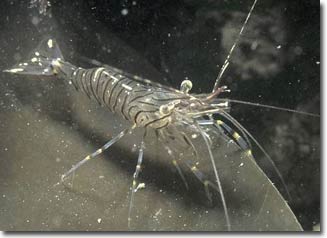Follow pandan shrimp
A new study by Leicester University reveals that fish species can use pandan to find the most nutritious food sources. Research on the behavior of sticklebacks has proved this. Sticklebacks use pandan to determine the best place to live, but pandan shrimp does not seem to have the aptitude to use sticklebacks for their benefit.
The study of the Department of Biology, Leicester University - conducted by Mike Webster (currently at St Andrews Academy), Ashley Ward and Paul Hart - was published in the Proceedings of the Royal Society.
Professor Hart said: 'Sometimes we look at other people's work, and don't know what to do next. That is very normal. One of the benefits of living in a social community like ours is by asking better people to help us succeed when we are unsure about a problem. Many people believe that human culture develops because people know how to observe and imitate each other's actions'.
 (Photo: Lancashiremcs.org.uk) Going into the animal world we see animal behavior as a precursor to human behavior. Is it different that these behaviors are not as perfect as we are but are all intended to solve the problem of survival and earn enough food.
(Photo: Lancashiremcs.org.uk) Going into the animal world we see animal behavior as a precursor to human behavior. Is it different that these behaviors are not as perfect as we are but are all intended to solve the problem of survival and earn enough food.
'We discovered an interesting thing is that sticklebacks can use other species to find suitable accommodation for themselves. They often appear next to pandan shrimp in brackish water areas, quite shallow with grass. '
Oddly enough, the sticklebacks rely on the appearance of pandan shrimp living in the environment like them to determine where to live . If a stickleback has to choose to follow a shrimp herd with the same conditions of living with it or follow another herd with a different habitat, it will certainly be entwined with the shrimp herd closer to it.
'Another experiment that proves this option is also important for food search. Compare that when a pack of pandan shrimp is familiar with the habitat, and a strange herd of shrimp all swim with water lice. The accompanying stickleback fish can only be seen but cannot be caught, but the closest number of "attacking" the lice is when traveling with the familiar shrimp. Choosing to go with pandan prawn that is close to the living environment not only affects the way of the stickleback fish, but also affects where to find food and even if it will be bait for any fish half.'
In contrast, pandan shrimp cannot use sticklebacks to find accommodation . They are attracted to other shrimp with the same habitat, not sticklebacks. As a result, the relationship between species becomes asymmetric. The species of sticklebacks exploits information from pandan shrimp, and pandan shrimp along with chemical signals become the guide for sticklebacks to the most suitable place.
This result illustrates the complexity of the relationship between species in the ecosystem.
Professor Hart added: 'We still think animals are primarily' communicating 'with their fellow humans and' ignoring 'other species. But this study has proven one thing: Like humans, animals have a lot of relationships with other species to create a diverse network based not only on predator relationships and prey. The ecosystem also contains important information networks where individuals with special classification capabilities have a multidimensional relationship that benefits at least one side. '
- Eyes of mantis shrimp
- 'Strange' work of doctor shrimp
- Discovering new abilities of mantis shrimp
- Video: Scary weapon of hammerhead shrimp
- The truth about shrimps is that many people think they know that they turned out to be wrong
- Killer shrimp 'annexed' African creatures
- Video: Sea shrimp skewered with belly, tearing the arowana in the blink of an eye
- The most monstrous 'killer' shrimp in the world
- Shrimps know how to shoot, like ... Songoku
- Australia creates sustainable super foods for farmed shrimp
- Finding shrimp in the UK simultaneously positive for drugs
- Artificial shrimp made from seaweed have nutritional value like real shrimp
 Is the magnetic North Pole shift dangerous to humanity?
Is the magnetic North Pole shift dangerous to humanity? Washington legalizes the recycling of human bodies into fertilizer
Washington legalizes the recycling of human bodies into fertilizer Lightning stone - the mysterious guest
Lightning stone - the mysterious guest Stunned by the mysterious sunset, strange appearance
Stunned by the mysterious sunset, strange appearance